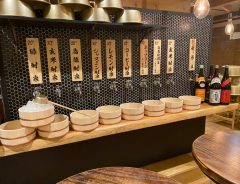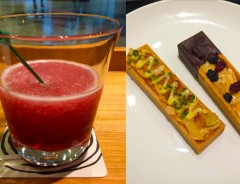Related Article
-

Never Drink Alone Again With This South Korean Robot Drinking Buddy
-

Lotte Coolish melon soda float ice cream is back with a fancier retro design
-

New Nagoya Izakaya lets customers pour their own all-you-can-drink chuhai from tap
-

We Tried Wine Frappuccinos And Tarts At Tokyo’s New ‘Starbucks Evenings’!
-

Illustrator Natsuya’s never-ending summer dreams of pools, popsicles, and aquamarine
-

Relive Japan’s outrageous gyaru style with these capsule toys



Whether it be Zima (yes, that Zima) or the somewhat infamously potent Strong Zero, ready-to-drink canned cocktails in Japan are a go-to for many looking to get a quick drink in after work. Particularly popular are chuhai, which is a portmanteau of “shochu” and “highball." Whether served fresh at a bar or in a can, chuhai typically pack a shochu base, carbonated water, and flavoring such as lemon or grapefruit--although many modern varieties substitute vodka and have a wide range of adventurous flavors.
Takara is one of Japan's leading shochu distilleries, and a maker of one of the country's first canned chuhais. So it's no surprise that one of their more popular modern canned chuhais is hailed as a return to basics and inspired by scenes you might find at an izakaya pub during Japan's Showa era (1926-1989). While this is true of Takara's flavors, there's one very distinct way the chuhai is a callback to the drink's roots--with these incredibly eye-catching and retro-styled cans depict the nostalgia of old-timey Japanese pubs in stylish illustrations:
(c) grape Japan
While the cocktails come in a variety of old-fashioned flavors, we decided to go with the standard lemon, umeboshi-wari (Japanese pickled plum mix), and Ramune (the beloved Japanese summertime soda) for our sampling of the drinks. First, lets take a look at the unique can that are like taking a stroll back into Japan's past.
(c) grape Japan
For the Lemon Shochu Highball, you'll notice an illustration of pubgoers enjoying lemon chuhai at an old-fashioned yakitori (chicken skewer) joint. A nice touch is that the paragraph describing the drink's flavor profile is written on white slabs on the bottom as if each sentence is a yakitori menu item.
(c) grape Japan
Next up was the Umeboshi-Wari Shochu Highball. The label features drinkers knocking back umeboshi chuhai, but replacing the yakitori is Japan's favorite winter stew--oden. Oden is a dashi and soy sauce strew that includes a hodgepodge of ingredients such as dashi and soy sauce broth include daikon radish, fishcakes, konjac, tofu, sausages, boiled eggs, and skewered meats. The extra sour punch of the pickled plum is said to pair well with such stews.
(c) grape Japan
Finally it was time for the Ramune Shochu Highball. As you can see on the label, this time the drinking has moved outdoors. That's because Ramune is often enjoyed at summer festivals in Japan, and served at food and drink stalls outside. Of course, one particular food stand here advertises what a customer is knocking back as "Ramune for adults" on a banner--which is exactly what this drink is!
(c) grape Japan
So while things are smooth in the looks department, how did they taste? Smooth is definitely not the word for it, but perhaps that's exactly what these "old timey" canned chuhai are going for. Takara's chuhai's definitely seem to be aimed at older drinkers, or at least those who prefer their booze with minimal masking flavors. For that reason, the flavors of umeboshi, lemon, and even ramune come in more as an subtle after flavor following a decisively sharp shochu kick. Even the Ramune flavor, while definitely present, took a backseat to the bite of the shochu--as you may be able to tell by the color.
(c) grape Japan
(c) grape Japan
Available in both 350ml and 500ml cans, and ranging from 5%-7% ABV, Takara's Shochu Highball series offers some of the country's coolest and unique looking cans that offer a stroll down memory lane--just be ready to taste your shochu!